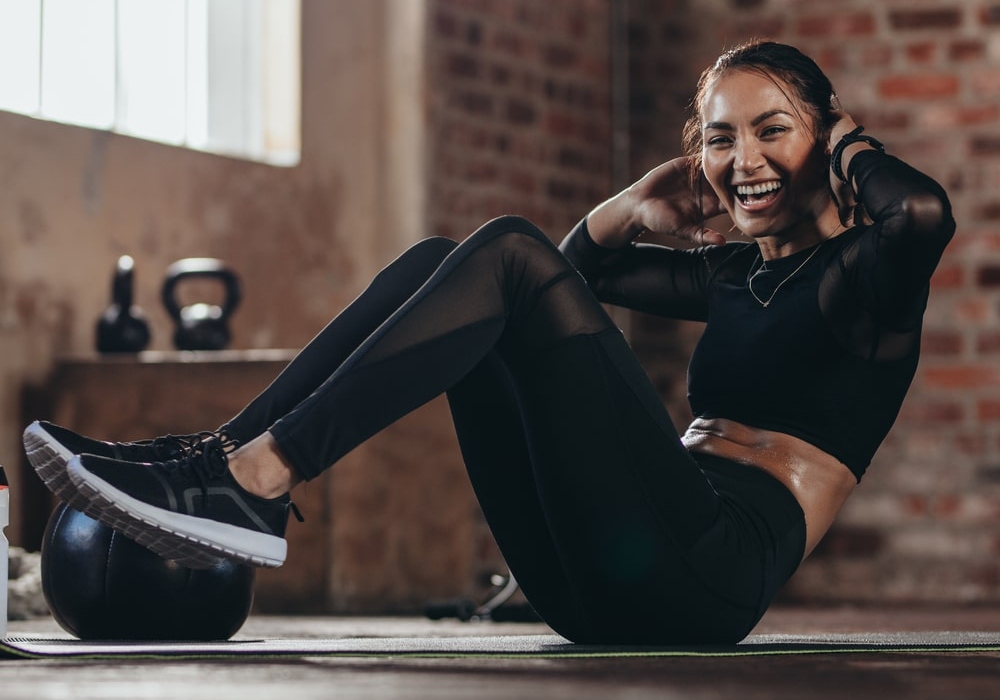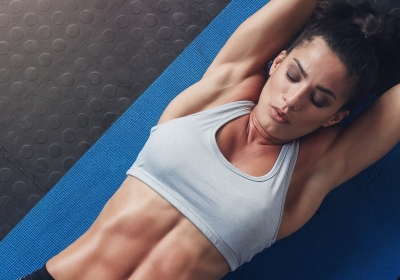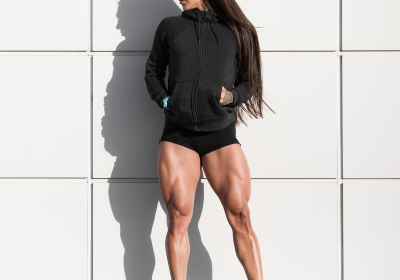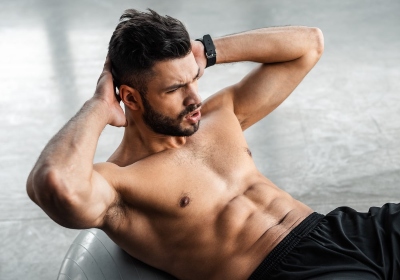VIDEO
Bulgarian Split Squat Explosive Jumps
- Core
- Lower Back
- Gluteus
- Quads
- Hamstrings
- Thighs
Level:Advanced
Trainer:Nick Taylor
Equipment:Bench
Bulgarian Split Squat Explosive Jumps
- Core
- Lower Back
- Gluteus
- Quads
- Hamstrings
- Thighs
Level:Advanced
Trainer:Nick Taylor
Equipment:Bench
Standing one or two feet feet from a bench or chair, place the top of your feet on the surface. With your head looking straight ahead, shoulders back and chest out, bend your front knee and lower your body as low as possible. This is the starting position. Now, drive from the heel forcely and push your body up. At the same time performing a small jump. Lift your foot quickly, and once it leaves the ground immediately place it to the receiving position. Returning to the ground, slowly bend your knee, so that you get back to the bottom position. Pause in this position for 1-2 seconds. Repeat for the desired amount of repetitions.
save to ...
RECOMMENDED FOR YOU
- Biceps
- Gluteus
- Hamstrings
Duaration: 00:49
save to playlist
ARTICLES
The oblique abdominal muscles are several groups of abdominal muscles on the sides of the core. The external oblique muscle lies on top and the internal oblique muscle - below it. Functional exercises for training them are bending, turning to the sides, and other rotating movements.
However, in order to work your obliques properly, you must remember that most exercises for the oblique muscles involve the other abdominal muscles, the inner transverse muscles, in particular. That's why you need to be able to consciously engage certain areas of the abs during the workout.
The oblique muscles represent the lateral part of the abdominal area. They act as the main rotators of the body. They are represented by two separate muscles, depending on depth and layer:
The outer oblique abdominal muscle forms the superficial layer. It is usually the target of training. It anatomically begins from ribs 5-12.
The internal muscle originates from the lumbosacral fascia, iliac crest, and inguinal ligament. It is attached to the area of the white line, cartilages of ribs 9-12, and pubic crest.
The main task of the oblique abs is to rotate the torso. Although, in addition to the main one, the muscle performs a number of functions:
Tilting of the torso.
Flexion.
Lowering the ribs.
The tension of the anterior abdominal chest wall.
Bilateral contraction.
In general, in order to work your abs properly, it is necessary to follow simple recommendations:
Eat lightly 2-2.5 hours before the exercise. If you train with an empty stomach, you will not work out to your full potential, which means that the workout will be ineffective. An overfilled stomach can also leave negative consequences, such as nausea and severe dizziness.
Warm up your muscles by doing light exercises. Jump, run on the spot or on a machine, do simple tricks like turns, twists, and turns.
Do not overdo it! You don't need to exhaust yourself every day. Try 2-4 times a week - that will be enough for a nice and shapely belly.
Each exercise should stretch your muscles. You should feel how they are tensed. If this is not there, then you are doing something wrong.
Do not eat immediately after the workout. If you feel very hungry, snack on an apple or drink a glass of water. Do not eat after one hour at the earliest.
Read more
The core is a series of muscles that start under the pectoral and extend to the pelvis. It also includes several groups in the back and other groups throughout the torso. A 'strong back' means a good physique and a healthy body. If you want to learn how to do this, learn to exercise at home or at the gym. Once you have achieved this strength, you can also learn to maintain it.
The midsection is the area of the body often referred to as the core and it involves everything in that area including the front, back and sides. It includes:
lower back.
the traverse abdominis (TVA);
erector spinae;
obliques;
If they are week it could cause lower back and waist pain. However, taking care of them can keep your posture healthy and make you stronger in other exercises like running and walking.
Training. One of the best core exercises is a plank. It provides minimal movement but maximal effort, demanding you to support your body on your hands and toes during holding your body in a straight line from your shoulders to your ankles. Also, you can rest on your knees If you need it or make it more difficult by extending your arms so you’re supported by your hands.
Bridge. Lie down on the floor. Put your arms straight down on the floor near your hips. Bend your knees. Lift your hips up and down.
Superman. Do a little push-up. Lie with your face down and stretch and arms forward and your legs backward.
V-Jumps. Sit on a bench or chair, lift your legs, tilt the core slightly forward so that your body forms a 45-degree angle. From this position jump up extending your hands above your head.
Pushup Variation. Put your hands and toes on the mat. Keep your arms straight, but don't lock your elbows. Align your feet making the straight line with your arms. Inhaling, lower your chest to the ground slowly. Straighten your arms to lift your core up, exhaling.
Inchworm Variation. Put your hands on the ground and your feet - on the elevated surface (a bench). Start walking your hands out, as far as you can keeping your legs straight throughout the movement. Make a pause. Walk your hands back up to the starting position.
Reverse Crunches Variation. Bend your legs at the knees and brace your abs to slowly raise your legs so that your knees are directly over your hips. Brace abs and hold the neutral spine position with a slight neutral curve in the lower back. Exhale as you contract the abs Your head should be kept straight and relaxed on the mat. Inhale and slowly return to the starting position.
Read more
One of the most important running muscles is the quadriceps - the large muscle at the front of the thigh. It has been scientifically proven that regular strength training improves workout performance and reduces the risk of injury, as well as strengthens your back, and leg muscles, making your running more productive.
The quads, also known as the quadriceps muscle, is a group of muscles located at the front of the leg above the knee. It is one of the largest and strongest muscles in your body that consists of four heads: fastus medialis (medial wide), vastus intermedius (intermediate wide), vastus lateralis (lateral), and rectus femoris (straight thigh muscle). Almost every action performed by the legs involves two or more heads of the quadriceps. The quadriceps muscle plays an important role at the beginning of the movement (quick start) and during ascent and descent in elevated positions - which is why you may experience painful sensations in this area of the leg after an intense uphill workout.
According to researchers at the University of Delaware, strong quadriceps act as cushioning and can protect the knees and the entire musculature of the hip from common running injuries. Often many runners are injured because they have weak and underdeveloped quadriceps, so it is especially important to strengthen them.
By training and strengthening the quads, you can get the following benefits when running:
Increased speed. Strong quadriceps help you tackle steep hills and climbs more easily and make pushing off the ground more powerful, resulting in increased speed.
Reduced injuries. According to research, poorly developed quadriceps are often associated with many running injuries. For example, a common injury such as the 'runner`s knee' results from weakness in these muscles, which are unable to stabilize the knee joint during the movement.
Increased endurance. Strengthening the quadriceps muscle will make your running more effortless and efficient, which contributes to increased running volume and endurance.
Training
The quadriceps occupy 70% of the muscle mass of the leg, so it is their development that is fundamental in leg training. The main exercise for developing the quadriceps is the squat. But, for beginners, at the first stages of training, it is better to start with leg curls sitting in an exercise machine, leg press, and hyperextensions to strengthen the lower back, to avoid injuries, in order to prepare the base for the heavy squats. It is a good idea to include squats in your training plan after about six months of training.
Read more
The hips are some of the strongest muscles in the human body. They keep the torso upright, control the hip and knee joints, and are engaged during various activities and even at rest. Their proper functioning is extremely important, and anyone should know how they function.
The muscles located on the hip are involved in both hip and knee movements, providing different positions of the hip in space depending on the proximal or distal support. Topographically, the hipі are divided into three groups. The anterior group includes the flexors: the quadriceps and the tailor muscle. The medial group consists of the hip drive muscles: the comb, the long, short, big adductor, and the thin muscle. The posterior group includes the hip extensors: biceps femoris, semitendinosus, and semi-perineal.
The lateral outer and inner thigh muscles are considered antagonistic pairs: while one group is working, the other group relaxes. The abductors, including the middle gluteal, small gluteal, thigh broad fascia tensor, pear, and tail muscles are responsible for your leg movements from the middle of your body.
Essentially, whenever you take a step to the side or turn your foot on the bed, you are activating the abductors. The inner thigh muscles, particularly the large adductor, small adductor, short adductor, and long adductor muscles perform the opposite task, working whenever you move your leg toward the center of your body.
Strong and injury-resistant athletes have well-trained hip muscles. This is very important when it comes to fast sports with a lot of lateral movements, such as tennis or basketball, but also when you want to work out without pain. If your goal is to strengthen your hip muscles, which is really important, but you don't have your favorite leg workout, we will share some great exercises with you.
Wide Squats. Every leg workout should include different variations of squats. This exercise targets the lower body, including the inner and outer thighs. But to really engage your thigh muscles, you should do deep squats with your legs turned outward.
Sumo Deadlift. The Sumo deadlift is based on a similar leg position as in the wide squat. However, it is the external rotation of the thigh muscles that results in increased involvement of the inner and outer thighs.
Side Leg Raises. A 2005 study published in the Journal of Orthopedic and Sports Physical Therapy found that side leg raises without weights are just as effective as other weighted exercises.
Side Leg Pull-Ups. The pull-up exercise can be done anywhere because you don't need anything but a comfortable mat. This is a great exercise that you can add to your daily home workout routine.
Read more
Since ancient times, developed muscles have been one of the hallmarks of a harmoniously developed, athletic body. There is no such thing as 'abs' in anatomy. This is a conditional abdominal muscle. There are four of them:
rectus;
internal oblique;
external oblique and transversus.
The rectus abdominis muscle is the largest in area. It’s a popular fallacy that there is a 'lower' and 'upper' press, but the rectus muscle does not have such a division. The notorious 'six-pack' stands out because of the tendon bridges on the rectus abdominis muscle. The muscle bundles of the external abdominal muscle begin from the lower eight ribs and extend radially downward. The transverse muscle is located deeper than the other abdominal muscles. In this case, the tendon extension in the upper two-thirds passes behind the rectus muscle, and in the lower third - in front. Partly because of this, the lower abs are less workable than the upper ones. The abdominal muscles are referred to as the core muscles, the muscle complex responsible for stabilizing the spine, pelvis, and hips. Each of the abdominal muscles is responsible for its own functions. One of the most common fallacies in abdominal training is that the more reps we do in a set, the stronger and bigger the abs will be. In fact, the muscles of the abs are no different in terms of training from the biceps. To increase the biceps, you will do one hundred reps per set. However, you will reduce the number of sets and reps, but increase the load. By increasing the number of repetitions in the set, you will develop strength endurance, but the muscle will not get thicker from this. It is much more effective to increase the load, do sets with weights and reduce the number of repetitions in the set. Three factors affect the appearance of your abs: posture, body fat percentage, and muscle development.
Posture.If a person pumps muscles but slouches, and he has excess fat, then the abs will not be visible. If a person does not pump the abs, but he has a good posture and a small percentage of body fat, then his belly will look flatter. That is why it makes no sense to start with the question of how to properly pump the abs. You need to start by working on your posture. The good news is that your core muscles are also responsible for correct posture. And they are usually used in workouts with an emphasis on the abs.
Fat percentage.Measuring body composition on an analyzer scale will show the percentage of body fat, which explains why the abs are invisible. If the fat is more than 15-20%, then it’s hard to see your six-pack. At 15% or less, the abs begin to be seen. 8% is abs athletes have. But do not try to completely get rid of fat for beautiful abs. Fat is necessary for the proper functioning of the endocrine system and other processes in the body. To achieve tangible results, it is important to monitor the factors that affect the percentage of body fat like food, sleep, stress levels, and the amount of daily physical activity.
Muscle development.You mustn’t focus only on abs exercises, you need to develop the body complexly and do a variety of activities. Strength training will strengthen your muscles, burn calories and build endurance with interval training. Recovery activities help with posture, flexibility, and muscle balance. The optimal training program can be selected after fitness testing, which takes into account how a person moves, what restrictions he has.
Read more
SAVE TO ...





